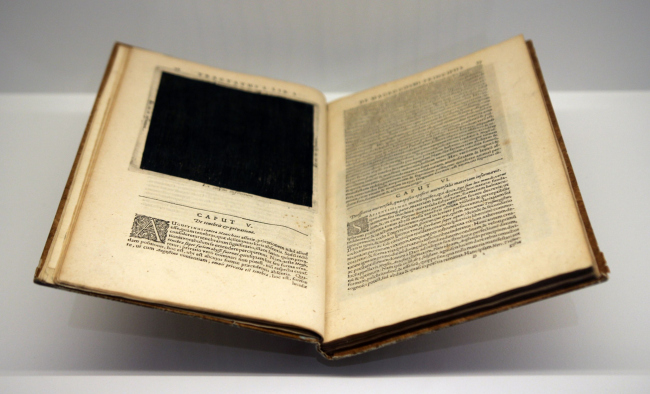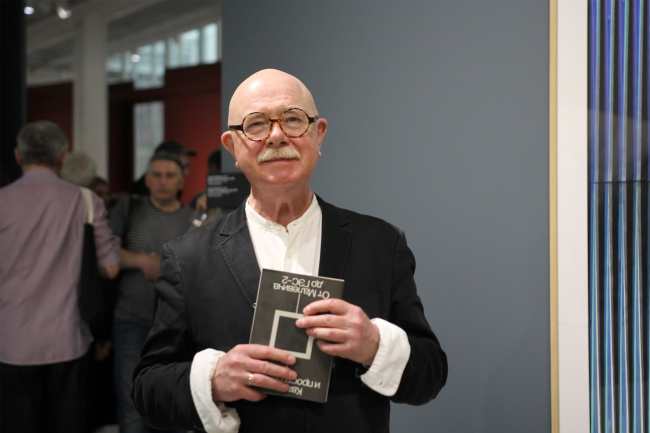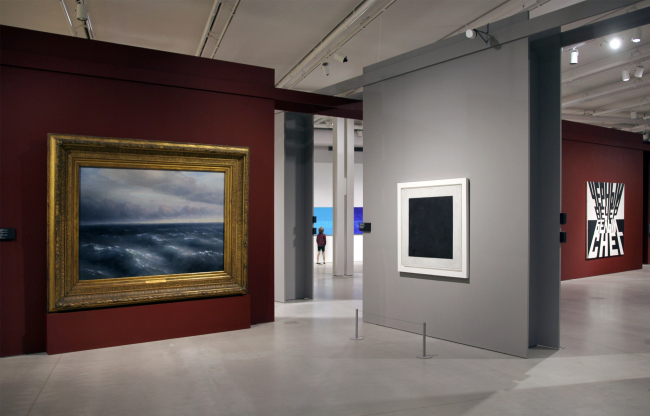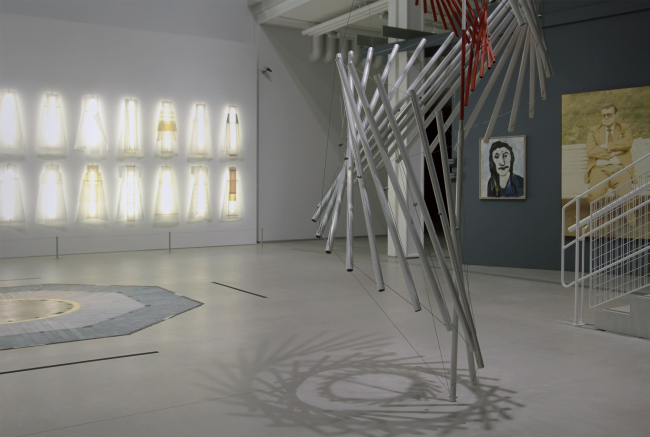|
Published on Archi.ru (https://archi.ru) |
|
| 24.06.2024 | |
|
Nuanced Alternative |
|
|
Julia Tarabarina |
|
|
How can you rhyme a square and space? Easily! But to do so, you need to rhyme everything you can possibly think of: weave everything together, like in a tensegrity structure, and find your own optics too. The new exhibition at GES-2 does just that, offering its visitor a new perspective on the history of art spanning 150 years, infused with the hope for endless multiplicity of worlds and art histories. Read on to see how this is achieved and how the exhibition design by Evgeny Ace contributes to it. The exhibition named “Square and Space: From Malevich to GES-2” which recently opened in the underground space of the “House of Culture” boasts a star-studded lineup. Francesco Bonami, a renowned contemporary art curator, publishes Flash Art magazine. In 2000, he curated the traveling contemporary art exhibition Manifesta in Ljubljana, and in 2003, he curated the 50th Venice Biennale of Contemporary Art, where the manifesto glorified “The Viewer’s Dictatorship”. In 2017, GES-2 published Francesco Bonami’s book “I Can Do That Too!” explaining “why contemporary art is still art”. As for Zelfira Tregulova, she was, until recently, the director of Moscow’s Tretyakov Gallery, into which she had brought a lot of contemporary art as well. 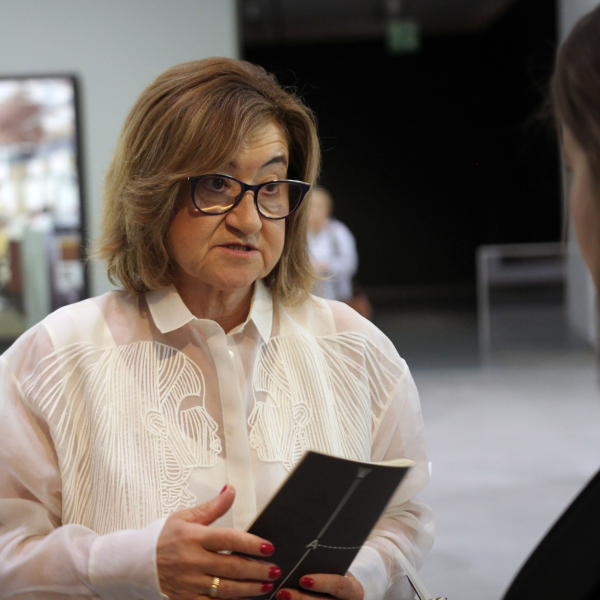 Zelfira Tregulova at the inauguration of the exhibition "Square and Space. From Malevich to GES-2". 20.06.2024 27.10.2024Copyright: Photograph © Julia Tarabarina, Archi.ru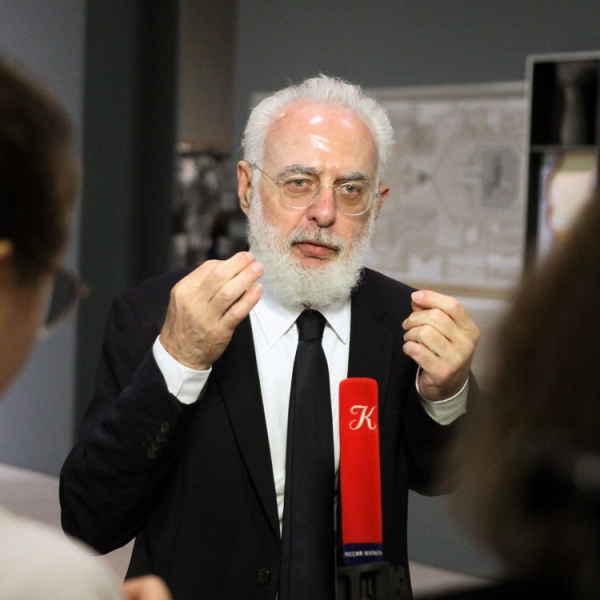 Francesco Bonami at the inauguration of the exhibition "Square and Space. From Malevich to GES-2". 20.06.2024 27.10.2024Copyright: Photograph © Julia Tarabarina, Archi.ruNow, Francesco Bonami and Zelfira Tregulova have come together to create an exhibition at GES-2, offering an intriguing angle on contemporary art and its history. As paradoxical as it may seem, contemporary art already has a significant history. It’s interesting to understand how much this history “weighs it down”, given that one of contemporary art’s key elements is novelty, a rejection of the old. How does one navigate this when your rejection of history has itself become a history over 110 years long? You need to respond to this contradiction in one way or another! The curators respond brilliantly, in my opinion. They use excellent examples from a historical span ranging from the Peredvizhniki and Aivazovsky to an installation by Ilya and Emilia Kabakov, created specifically for the exhibition, to show that alternative histories of contemporary art – just like Max Fry’s alternative worlds – can be endless. By looking at the echoes of the “Black Square” from a slightly different angle, everything changes a bit; and there can be many such angles. The perspectives for creative reimagining of art history are fundamentally open. This novelty lies specifically in the curators’ approach, and not in Francesco Bonami’s comparison of the “Black Square” to a QR code. This last innovation seems somewhat contrived to me. The exhibition itself is excellent. The exhibits are of high quality, from good collections, and very diverse. There are even two codices, where the curators found “black squares done before Malevich” (sic!) as a lyrical digression: one from 1880 depicts a “battle of black men in a dark room”, and the other, an even earlier one, shows “darkness before the creation of the world”. Creation of the world as a black rectangle. Exhibition "Square and Space. From Malevich to GES-2". 20.06.2024 27.10.2024Copyright: Photograph © Julia Tarabarina, Archi.ruAccording to the curators, the exhibition begins with the “Black Square” (not the original, but an authentic repetition by Malevich) and ends with a total installation by the Kabakovs. However, if we are to look from the chronological standpoint, the beginning of the exhibition is Aivazovsky’s “Black Sea” from 1881, which pairs Malevich at the entrance, along with several other 19th-century paintings. The ending is not another Kabakov installation but one by Vladimir Seleznyov, dated 2024. Both the Kabakovs and Seleznyov are a highlight. The Kabakovs’ installation named “Incident in the Museum, or Water Music” is a series of rooms from a “retrospective” of the entirely fictional artist Stepan Koshelev, a Cezannist/Social Realist, featuring milkmaids, dachas, skis, and a mock catalog signed by none other than Alpatov. The exhibition is convincingly executed, and the paintings are skillfully done “by all the canons of the genre.” However, the installation suggests that “something went wrong,” and on the opening day, the ceiling leaked, leaving the rooms filled with basins catching water from tubes installed under the ceiling, resembling sprinklers, but without nozzles. The main theme is thus the music created by the dripping water, though in reality, it is the embarrassment and awkwardness of the leak that take center stage. At this point, I couldn’t help but recall the opening of the Russian Pavilion at the 2008 Architecture Biennale. Even the walls in the first room are red, and the name Koshelev would ring a bell for anyone interested in contemporary architecture. There is one big “but”, though: the Kabakovs created this installation in 1992, long before any of these events were planned... 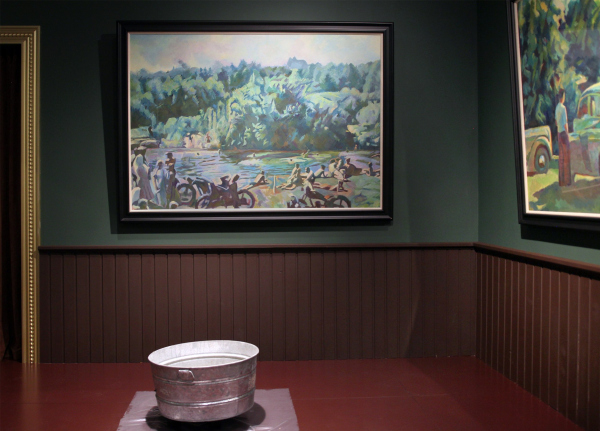 Exhibition "Square and Space. From Malevich to GES-2". 20.06.2024 27.10.2024Copyright: Photograph © Julia Tarabarina, Archi.ru Exhibition "Square and Space. From Malevich to GES-2". 20.06.2024 27.10.2024Copyright: Photograph © Julia Tarabarina, Archi.ruVladimir Seleznyov’s installation is not as immersive as the Kabakovs’, but it can be equally interesting for those with an architectural mindset. It is titled “Metropolis. Traum(a)stadt”; the second word translates from German as “city of dreams” though for Russian and English speakers, it also resonates with the word “trauma”. This play on words is likely intentional, inviting contemplation on whether dreaming is inherently traumatic for the Russian psyche. For all intents and purposes, this name was not chosen by accident – I could go on and on about whether it’s really traumatic for a Russian individual to dream, but I digress. The essence of the installation, placed in a dark room, is a city constructed from trash. When the lights come on, we see that it is unmistakably trash, but when the lights switch off according to a schedule, the objects marked with phosphorescent paint transform into a cityscape, resembling a somewhat zombified city with a greenish tint. The author’s view on the metropolis and its trashy allure is apparent (he doesn’t think much of a metropolis, to put it bluntly), yet the scene mesmerizes you precisely because this heap of trash strikingly resembles a real city. 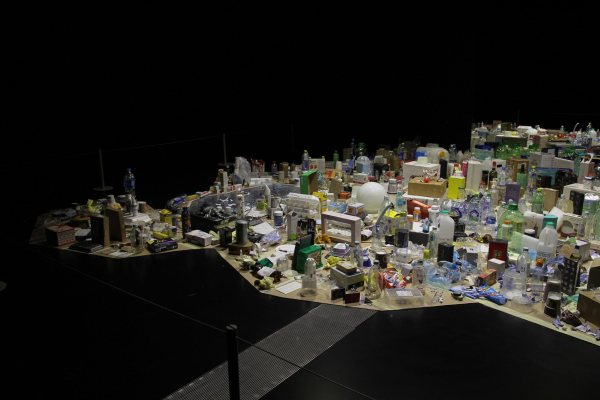 Vladimir Semyonov. "Metropolis. Traum(a)stadt." Installation. 2024. Exhibition "Square and Space. From Malevich to GES-2". 20.06.2024 27.10.2024Copyright: Photograph © Julia Tarabarina, Archi.ru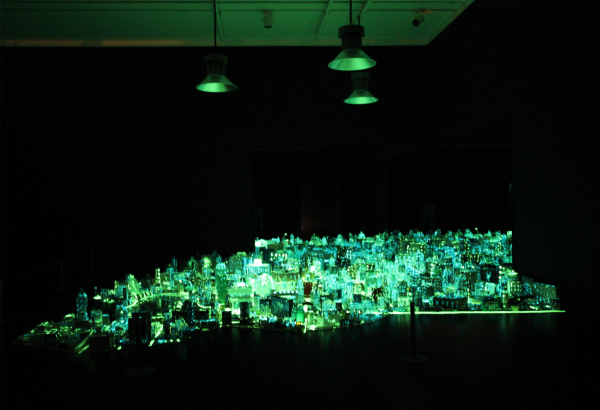 Vladimir Semyonov. "Metropolis. Traum(a)stadt." Installation. 2024. Exhibition "Square and Space. From Malevich to GES-2". 20.06.2024 27.10.2024Copyright: Photograph © Julia Tarabarina, Archi.ru Vladimir Semyonov. "Metropolis. Traum(a)stadt." Installation. 2024. Exhibition "Square and Space. From Malevich to GES-2". 20.06.2024 27.10.2024Copyright: Photograph © Julia Tarabarina, Archi.ru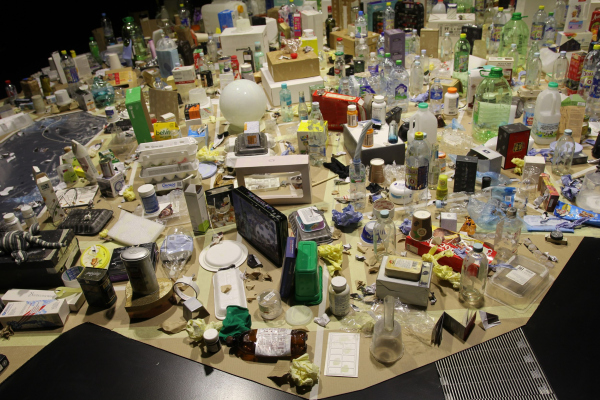 Vladimir Semyonov. "Metropolis. Traum(a)stadt." Installation. 2024. Exhibition "Square and Space. From Malevich to GES-2". 20.06.2024 27.10.2024Copyright: Photograph © Julia Tarabarina, Archi.ru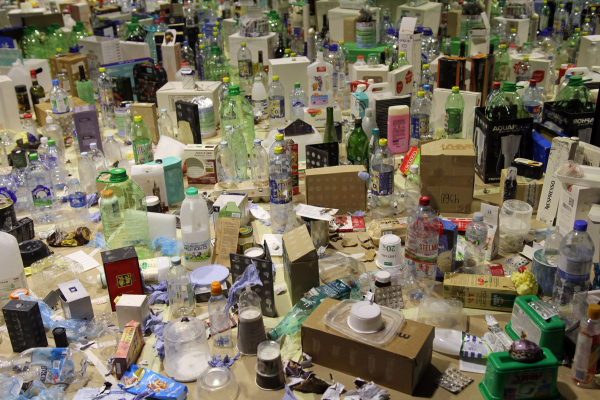 Vladimir Semyonov. "Metropolis. Traum(a)stadt." Installation. 2024. Exhibition "Square and Space. From Malevich to GES-2". 20.06.2024 27.10.2024Copyright: Photograph © Julia Tarabarina, Archi.ru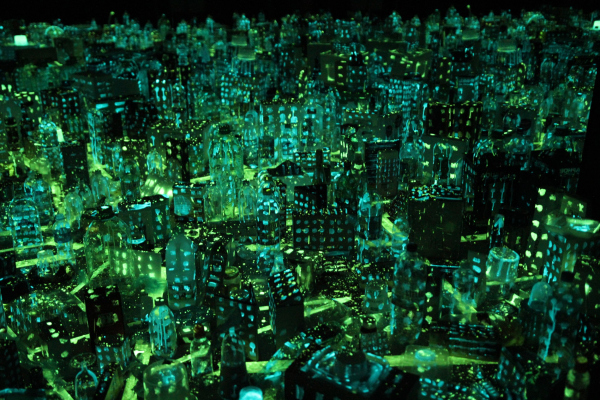 Vladimir Semyonov. "Metropolis. Traum(a)stadt." Installation. 2024. Exhibition "Square and Space. From Malevich to GES-2". 20.06.2024 27.10.2024Copyright: Photograph © Julia Tarabarina, Archi.ruThe exhibition develops chronologically from the old to the new, with well-known works and authors juxtaposed and even intermixed with those familiar solely to contemporary art specialists. Nonetheless, a determined visitor, who thoroughly explores the exhibition (going preferably a couple of times back and forth), will indeed feel acquainted with an alternative version of the last 150 years of contemporary art history, encompassing all of its key movements: realism, abstraction, optical art, tensegrity structures, photorealism, and total installations. It might even be possible to pass an exam on contemporary art after such a visit, despite the lack of obvious textbook examples –the “Black Square” being the only exception So, the curators offer us a nuanced alternative history of contemporary art, based on “solid” items (not random by any means!) from good collections, including, of course, the V-A-C collection. They clearly suggest that this “revolution” has neither an end (since contemporary art continues developing) nor a beginning (since it is not so difficult to trace it back to 19th-century realist painting and old Latin codices – when they depict the world before the beginning of time or the battle of the negroes). We haven’t even mentioned the pre-classical alabasters yet... Nevertheless, one of the main emotions the exhibition evokes is this slightly new perspective, fundamentally open, indicating that there can be many angles, and the chronological “loose ends” aim at the absence of rigid boundaries. All this was helped to be expressed by the architect Evgeny Ace with his exhibition design. Exhibition "Square and Space. From Malevich to GES-2". 20.06.2024 27.10.2024Copyright: Photograph © Julia Tarabarina, Archi.ruThe fundamental openness of the curatorial statement in the space is visually represented by the plane of a stand visible through the glass separating the exhibition hall from the cloakroom, a kind of red (rather, terracotta!) wedge that suppresses (but not completely!) the otherwise white space of GES-2. This is supported by the fascias, most of which hang on the ends of the stands.  Exhibition "Square and Space. From Malevich to GES-2". 20.06.2024 27.10.2024Copyright: Photograph © Julia Tarabarina, Archi.ru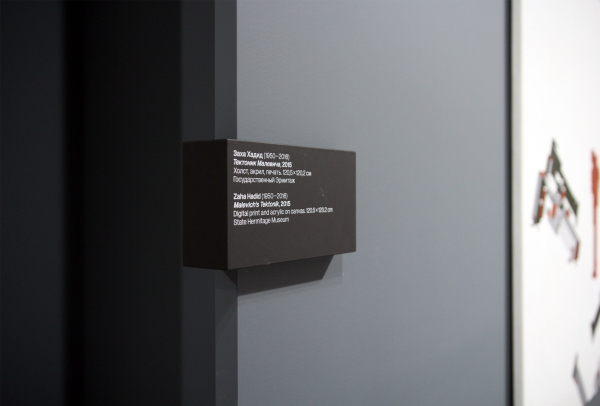 Exhibition "Square and Space. From Malevich to GES-2". 20.06.2024 27.10.2024Copyright: Photograph © Julia Tarabarina, Archi.ruInside, in the space of the hall, divided by the GES-2 supports into three naves, three other naves of a smaller size are inscribed, made of stands of several muted shades, connected at the top by flat strips – at an angle, like several linear hangings, with one “rope” intersecting above the other, looking very much like a housewife hangs laundry in the yard, although we now mostly see this mise-en-scène in movies. The lines of the building’s metal supports, duplicated by drainage strips on the floor, run in one direction, while the lines of the stands are at an angle to them. The two structures intersect; two spatial grids overlap each other, as if visibly representing the idea of looking at contemporary art from a slightly different, though not perpendicular, angle. 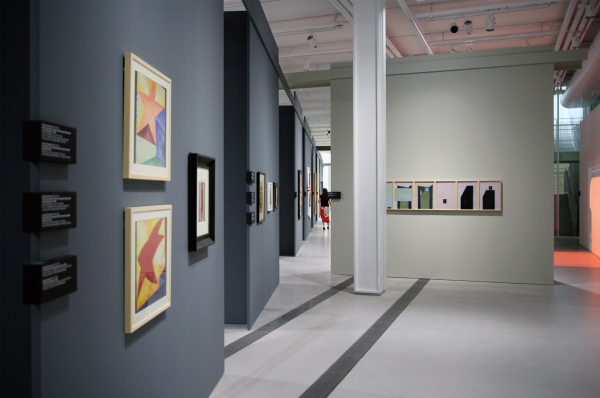 Exhibition "Square and Space. From Malevich to GES-2". 20.06.2024 27.10.2024Copyright: Photograph © Julia Tarabarina, Archi.ru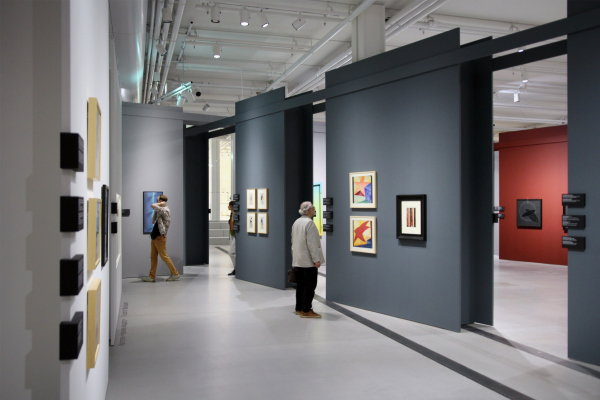 Exhibition "Square and Space. From Malevich to GES-2". 20.06.2024 27.10.2024Copyright: Photograph © Julia Tarabarina, Archi.ruBut then again, the angle at which the lines of the stands are set is not arbitrary. The central promenade starts behind the Black Square, and the square is turned towards the entering person as the key exhibit. Thus, the axis of Malevich’s “Black Square” strings together 20th-century art. The exhibition booths themselves are subjected to a certain modular width, standing with large gaps between them, so while the lines are marked, one can stroll along and across in various directions, providing a wide choice of sometimes unexpected perspectives. Thus, in the space of GES-2, “streets” and “squares” (sic!) are formed, which Francesco Bonami considers linguistically friendly to the “Black Square”. The layout turned out to be modernist, composed of individual plates, and not just modernist, but “late-modernist” from the 1980s, because the plates are not set at a daring 45° angle and not end-on to the red line, but rather hold their formation, albeit intermittently, like on Moscow’s Sergius Radonezh Street (formerly Tulinskaya until 1992). 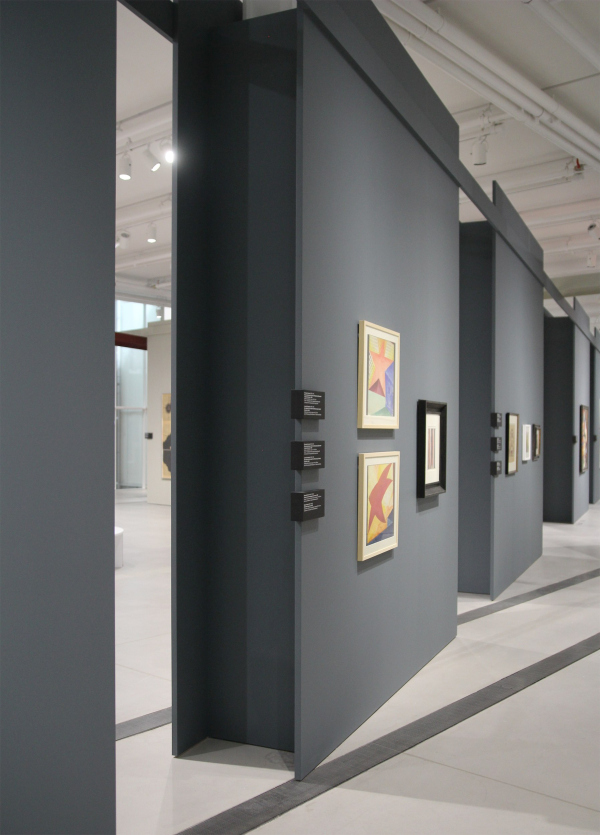 Exhibition "Square and Space. From Malevich to GES-2". 20.06.2024 27.10.2024Copyright: Photograph © Julia Tarabarina, Archi.ru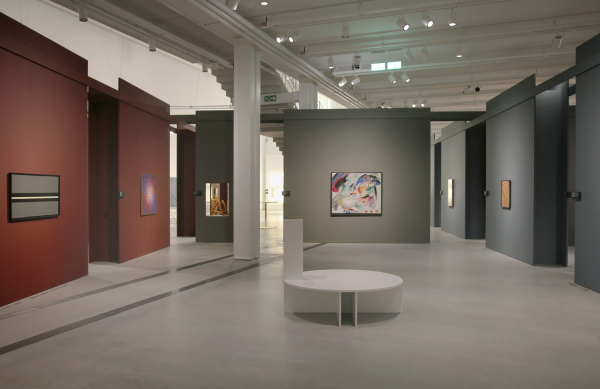 Exhibition "Square and Space. From Malevich to GES-2". 20.06.2024 27.10.2024Copyright: Photograph © Julia Tarabarina, Archi.ruThe ends of the exhibition booths are not cut straight but slightly protrude, echoing the plaques of the fascias and the very first title “tail” of the exhibition, as if each stand is formed, like a sandwich, from two outer plates and a filler. A similar H-beam contour can be seen in the metal supports of GES-2, and they resonate with each other. I asked Evgeny Ace if this resemblance was intentional – no, he said, the stands have such a contour simply to lighten their construction. However, if it seems that way to the visitor, then so be it, reassured the author of the exhibition design. Well, I’ve got nothing against it either. Nevertheless, the booths indeed look like overblown pillars, very akin to the original interior, as if a modified DNA had been grafted onto them, causing them to develop in a similar but slightly different way. A rather curious effect! By the way, more about the city! Besides having a “city within a city” – that same “Metropolis” like a large model at an architectural exhibition, and a “show within a show” (the total installation by the Kabakovs), there is also a “little house inside GES-2” which seems to be becoming a tradition in this day and age. Here, the little house is of approximately the same size: the exhibition includes an authorial repetition of the “Shed” designed by Meganon Architects. As the tour guide told us, in Nikola-Lenivets – where it was built in 2006 – this house was more of a lantern, while here it serves more to cast shadows in its interior, similar to the classic “shadow gaps”, so much loved by Renzo Piano. 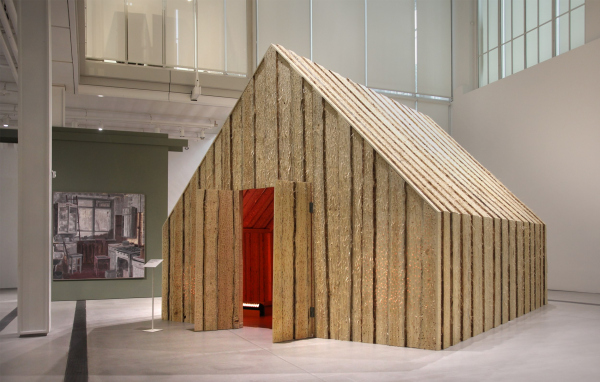 Exhibition "Square and Space. From Malevich to GES-2". 20.06.2024 27.10.2024Copyright: Photograph © Julia Tarabarina, Archi.ru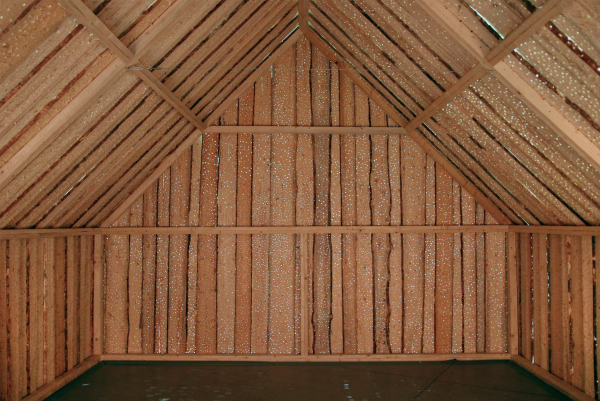 Exhibition "Square and Space. From Malevich to GES-2". 20.06.2024 27.10.2024Copyright: Photograph © Julia Tarabarina, Archi.ru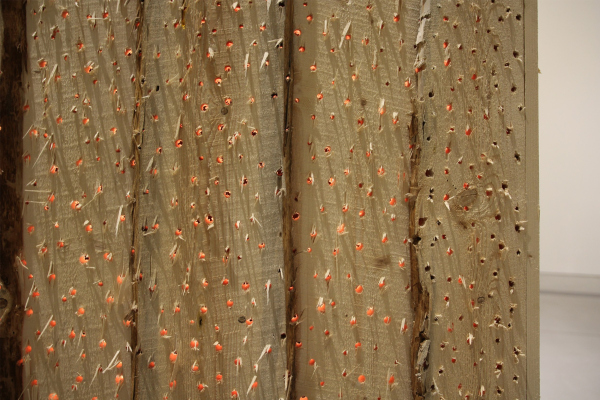 Exhibition "Square and Space. From Malevich to GES-2". 20.06.2024 27.10.2024Copyright: Photograph © Julia Tarabarina, Archi.ru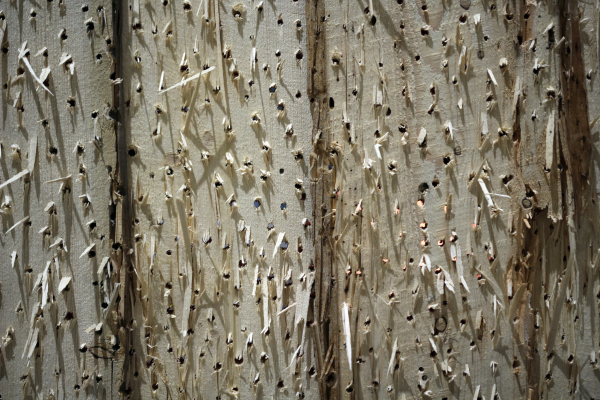 Exhibition "Square and Space. From Malevich to GES-2". 20.06.2024 27.10.2024Copyright: Photograph © Julia Tarabarina, Archi.ruI asked Evgeny Ace if he was the initiator of the authorial reproduction of the long-lost Shed – again, he said no. But it’s gratifying to see the object as an old acquaintance. The free yet confidently directed construction of “streets” and “squares” in the exhibition is echoed by its internal orchestration. There are many narratives and even more shapes here, resonating with each other, creating dialogues, rhythmically paired, and sometimes even more complex. For example, at the beginning of the exhibition, we see several landscapes divided by the horizon into two halves, close to two strips of abstraction. One of them is Aivazovsky’s “Black Sea”, sky and water, a pair to the “Black Square” by name and minimal figuration, because the chaos of waves, so well captured by Aivazovsky, is minimally figurative. It should be noted that on the same exhibition booth “behind” Aivazovsky, there are two more landscapes divided similarly; the curators subtly play on the edge of abstraction and reality in 19th-century art, but what’s really interesting is that the same line (and this is visible from the entrance), further includes the work of Erik Bulatov, a lover of “Horizons” – the painting “Black Evening / White Snow” luxuriously interpreting both the perspective and the monochrome of the “Black Square” and the non-objective division into sky and earth. This is something that we can understand as “the separation of heaven from earth” or “darkness from light” as in the mentioned book of the Old Testament. Exhibition "Square and Space. From Malevich to GES-2". 20.06.2024 27.10.2024Copyright: Photograph © Julia Tarabarina, Archi.ruYou enter, see this not-so-simple but obvious rhyme, and understand that there will be plenty of such things here. Just as the space is tied together by rows of showcases and lines of free passages, so do the exhibits resonate with each other, forming many threads, sometimes in subtle, and sometimes the most obvious way. Take, for instance, the shadows from the kinetic objects of Kolaichuk and Francisco Infante on the floor next to the horizontal plane projection of the Qubbat as-Sakhrah shrine, which one cannot step on (marked by a pair of black strips). Nearby, there is another shrine, paper sacred vestments; and so on. Here, if you wander, look, and think, you can find a lot for yourself, much of it seemingly accidental, but not so accidental. Exhibition "Square and Space. From Malevich to GES-2". 20.06.2024 27.10.2024Copyright: Photograph © Julia Tarabarina, Archi.ru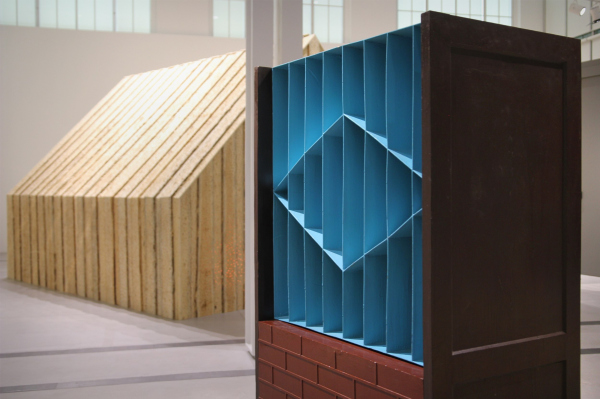 Exhibition "Square and Space. From Malevich to GES-2". 20.06.2024 27.10.2024Copyright: Photograph © Julia Tarabarina, Archi.ru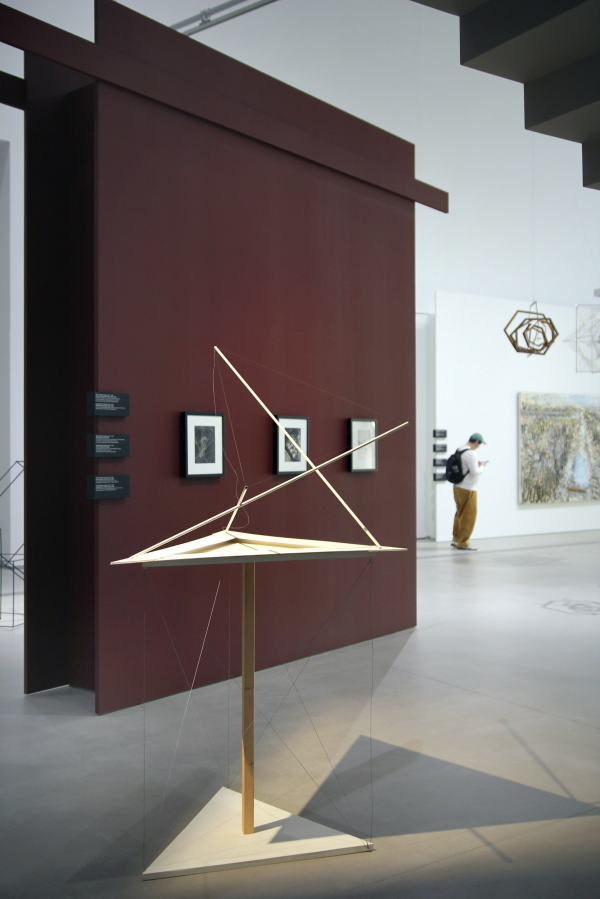 Exhibition "Square and Space. From Malevich to GES-2". 20.06.2024 27.10.2024Copyright: Photograph © Julia Tarabarina, Archi.ruPerhaps the high level of orchestration combined with a high level of freedom – both in space and selection – is what makes the exhibition truly magnificent; the selection of items is also important, but it is naturally expected from a good curator, while making them string together, making them “have a conversation” in space, sometimes even facing away from each other – that is something of great value. |
|
